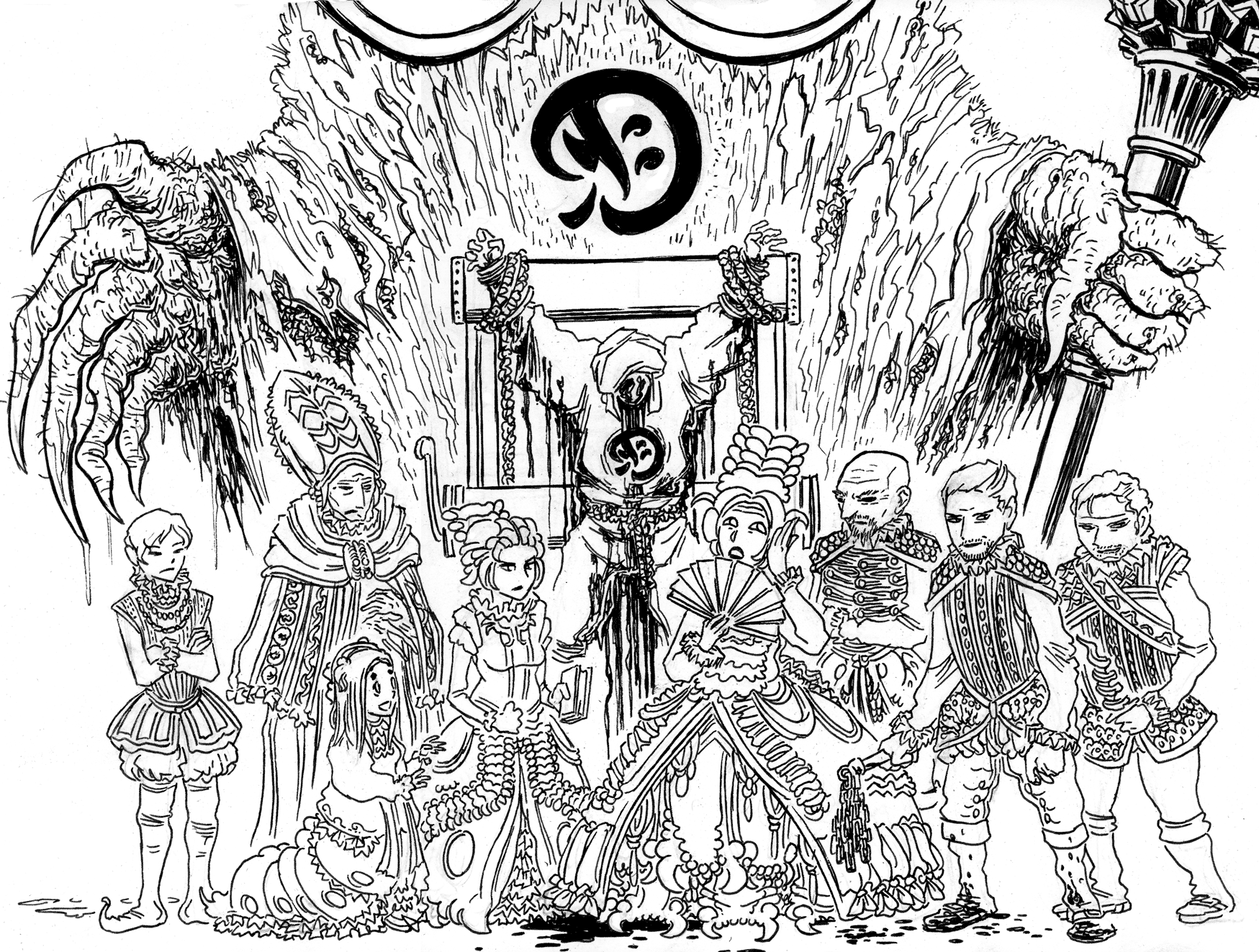Lovecraft Sketch MWF: The King in Yellow
The King in Yellow is a mystery wrapped in an enigma around a series of very obscure literary borrowings. Robert W. Chambers took a few names from an Ambrose Bierce story, H.P. Lovecraft took a few names and ideas from Robert W. Chambers, and then August Derleth came along and took Lovecraft’s ideas and grafted his own ideas onto them… It’s such a tenuous thread, and it results in a challenge for artists and authors trying to build from the material. It’s hard to create a unifying theme around a creature/entity/thing which is connected to (A) a giant tentacled alien lake monster on a distant planet, (B) a sinister cult which can resurrect corpses, and (C) a decadent, Yellow 1890s literary work which drives people insane.
But connecting such distant connections is what Cthulhu Mythos fans do, and when a Dream-Quest Kickstarter supporter asked me to draw the cast of the play The King in Yellow, based on a very detailed description, I was happy to give it a shot. The supporter’s synopsis version of The King in Yellow (which is one step away from being turned into actual play, and he really should consider finishing it) is filled with backstabbing and tragedy. Everyone’s hands are bloody, everyone glares at everyone else with barely concealed hatred. (Although their core character designs are pretty cute and manga-ish, but…) I went with an insectoid theme for the clothes of the Royal Family, in keeping with the theme of decay. Behind them, tied to the rack, is the Phantom of Truth, and behind that, towering above them all, is the King itself.
The King’s chest bears the infamous Yellow Sign, or at least my version of it, loosely inspired by certain Japanese kanji characters (although technically, this is a cheat since if it’s an alien symbol, it shouldn’t bear any similarity to any earthly language. But perhaps the kanji themselves are derived from the Yellow Sign, instead of the other way ’round). Since the King (whose face cannot be shown) is sort of an expanded and distorted version of its messenger the Phantom, perhaps even this is not the true King, but merely the messenger of an even greater and more inhuman entity, and so on and so forth, in the beginning of an infinite chain… a Kafkaesque series of gates, a wheat and chessboard puzzle in which the first King is merely slightly off-looking but each successive one becomes more and more monstrous, until the viewer/reader begs you to stop, to not turn one more page, to not open one more gate, to go one step farther on the infinite corridor of rotten-pawed monsters that form the endless succession of Carcosa’s Kings….
Over the weekend I participated in the Steampunk Design Challenge at Dead End Press, an art space in Ballard in Seattle, and won 2nd place for my drawing of a steampunk Ada Lovelace. It was a great show in a great space, and I hope they do more events! They’re looking for renters for studio space in case anyone is interested.
Other Monday news: there’s a new strip up at King of RPGs! And, if you want to see me draw something else, commission a sketch!

In some parallel worlds it is “The King In Yellow” that is given the movie treatment by Orson Wells over “Citizen Kane.” The elements I like except for August Derleth. I stay away from any changes he made. It just muddled up so much. Getting Robert W. Chamber’s work and reading them are a must. Some of it you can read for free on the Internet.
It’s only now on a second go-round that I noticed the “hems” of the “dresses.”
Ugh. Deeply creepy. Well-done!
Thanks! I thought I’d mentioned it in the post, but the designs for the characters beneath the King were actually based on descriptions provided by the person who commissioned this sketch. He didn’t describe their clothes, though, so I made those up.
Was the play ever finished? :)
The point is that you never get to read or see the entire play. We are played with like with the “Necronomicon” most of it is just not explained so everyone can envision their own horrors. Never give it all. Leave some dangling or better, contradictory, to the readers. An early form of reader interaction.
We can talk about the play, “The King In Yellow” just so we never right all or most of it. Little bits here and there important to the story. Like the book or record that causes suicides. Real? Stories of it persists, but…real? Keep them guessing.